Dinosaurs have captured our imagination for so long that the very name creates visions of such huge entities as Tyrannosaurus rex and Brachiosaurus. However, it’s not all giants; a large proportion were smaller species, and most of those played vital roles in their ecosystems. The small dinosaurs and other extinct animals supply much insight into the diversity of life during their time and also into the evolutionary adaptations which allowed them to survive and flourish.
The significance of these small dinosaurs goes beyond size alone. They possessed quite distinct characteristics and behaviors than their larger cousins. They were the feathered hunters and agile, agile herbivores that lived side-by-side with giants. For instance, the smallest dinosaurs explain much about the ecological dynamics of the Mesozoic era. In this article, we’ll explore 19 of the smallest dinosaurs and prehistoric animals, including their special features, behaviors, and vital roles in their environments.
What Defines Small Dinosaurs and Prehistoric Animals?
As far as dinosaurs and older creatures are concerned, it’s relative to say them small. Although many are longer than 30 feet in length, small species often measure less than 10 feet, with the smaller species being less than a few feet or a little smaller. This classification helps to broaden the mindset about how many species really fit in with their areas. Size can play the largest role in what exactly a creature might be up to, such as preying and defensive tactics as well as social behaviors and sometimes reproductive habits.

Small dinosaurs and other ancient creatures tended to develop in ways to occupy ecological niches within their ecosystems. They would do this either by allowing themselves to easily evade predators or to be able to feed on sources unavailable to larger species or occupy areas that cannot be reached by the larger animals. Most of these smaller species were well adapted, including agility, increased speed, or special diets that would better enable them to survive. In doing so, we can see how the size of organisms may determine the ecological niches of different species.
The study of small dinosaurs is also crucial in terms of showing evolutionary trends and diversifying species. Over millions of years, changes in ecosystems often meant that smaller animals succeeded in niches that were less competitive or vulnerable to extinction. Evolutionary paths taken by these small dinosaurs and their prehistoric counterparts can reveal a lot about resilience and adaptability in the face of environmental shifts, underscoring their importance in the grand tapestry of prehistoric life.
The 19 Smallest Dinosaurs
1. Microraptor

The most popular of the small dinosaurs is the Microraptor, measuring 2.5 feet in length. The Early Cretaceous era dinosaur is known for its feathers on both arms and legs, which means that it has four wings. It’s believed to be a pretty agile glider, moving through trees and snagging prey with its wings. Probably, the diet consisted of small animals and fish, as Microraptor used its sharp teeth and acute eyesight for hunting. Fossils reveal that Microraptor had iridescent feathers, and this will tell much about its looks and behavior.
| Feature | Description |
|---|---|
| Size | About 2.5 feet (0.76 meters) long |
| Period | Early Cretaceous |
| Diet | Carnivorous (small animals and fish) |
| Key Features | Four wings, feathered body, sharp teeth |
| Habitat | Forested areas, likely tree-dwelling |
| Significance | Insights into the evolution of flight |
2. Parvicursor

Parvicursor, about 1.5 feet (0.5 meters) in length, is a small, Late Cretaceous, theropod dinosaur. Its slender, long-limbed nature would suggest that it probably ran quickly, which gave it time to escape threats. A nimble, insectivorous and a small vertebrate-eater, the diet of a parvicursor consisted primarily of these two. As the fossil evidence shows, it also had sharp claws, possibly for catching small prey or climbing. This dinosaur exemplifies adaptations of small theropods to survive in a world dominated by larger predators.
| Feature | Description |
|---|---|
| Size | About 1.5 feet (0.5 meters) long |
| Period | Late Cretaceous |
| Diet | Insectivore (insects and small vertebrates) |
| Key Features | Slender body, long legs, sharp claws |
| Habitat | Varied environments, possibly grasslands |
| Significance | Adaptations for speed and hunting |
3. Homalocephale

Homalocephale was a relatively small dinosaur, measuring only about 3.5 feet in length, with the notable flattened head. It is believed that it lived in the Late Cretaceous period. This dinosaur, most probably, was herbivorous and fed on lowlying plants. It is suspected that the head structure helped in social behavior, in the form of display and head-butting in their mating rituals. Fossils would show that it was built with a sturdy body and strong limbs and should, therefore, indicate that this was an adaptation to its environment.
| Feature | Description |
|---|---|
| Size | About 3.5 feet (1 meter) long |
| Period | Late Cretaceous |
| Diet | Herbivorous (low-lying plants) |
| Key Features | Flattened skull, robust body |
| Habitat | Forests and plains |
| Significance | Insights into social behavior in dinosaurs |
4. Hypsilophodon

Hypsilophodon was a herbivorous dinosaur about 6.5 feet long. A member of the Early Cretaceous, it could run with the ease that would provide it the freedom from possible predators due to its long leg and agile body. It had probably eaten on leaves, low bushes, and other kinds of plants. The fossil found shows that its skeleton is too light, and this is a proof that it’s designed for running speed, agility. This dinosaur is an excellent example of how being small can be a plus in a competitive environment.
| Feature | Description |
|---|---|
| Size | About 6.5 feet (2 meters) long |
| Period | Early Cretaceous |
| Diet | Herbivorous (leaves and shrubs) |
| Key Features | Long legs, lightweight skeleton |
| Habitat | Open woodlands and scrublands |
| Significance | Adaptations for speed and evasion |
5. Lesothosaurus
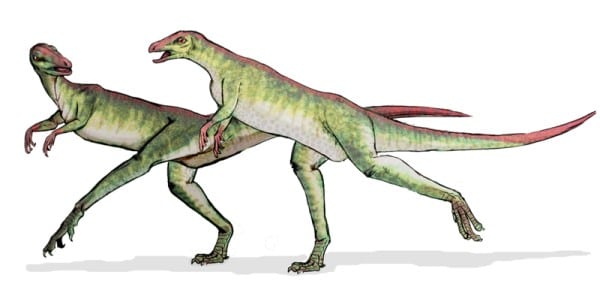
Lesothosaurus is about 4.5 feet long (1.4 meters). A small bipedal Early Jurassic dinosaur, it may have provided protection against larger predators with its slender shape and fast pace. It was a herbivore that fed on ferns and low-lying vegetation. Its fossil shows a beak-like mouth, which could well have helped in cropping the plants. Lesothosaurus is very important to understand the diversity of the early ornithischians and their ecological roles.
| Feature | Description |
|---|---|
| Size | About 4.5 feet (1.4 meters) long |
| Period | Early Jurassic |
| Diet | Herbivorous (ferns and low vegetation) |
| Key Features | Slender build, beak-like mouth |
| Habitat | Wooded and open environments |
| Significance | Diversity of early ornithischians |
6. Miniature Iguanodon

Although known from much larger relatives, the smaller forms of Iguanodon did exist. They would have been many feet in length shorter than the family members. Typically around 6 feet in length and rather similar in all external respects to their much larger relatives, small Iguanodon could also raise their thumb spikes, somewhat in the same way that the larger dinosaur employed the spike on its thumb in the defense of plant material. Probably an herbivore that fed upon the lower-lying plant material with its herd members for additional safety against predators, the animal must have had quite strong social features.
| Feature | Description |
|---|---|
| Size | About 6 feet (1.8 meters) long |
| Period | Early Cretaceous |
| Diet | Herbivorous (low-lying vegetation) |
| Key Features | Thumb spikes, social behavior |
| Habitat | Forests and open plains |
| Significance | Insights into social structures in herbivores |
7. Pectinodon

Pectinodon was a small theropod dinosaur, measuring around 2 feet (0.6 meters) in length. It lived during the Late Cretaceous period and is known for its unique teeth, adapted to eating small prey and possibly fruits or seeds. Its light body and slender limbs indicate that it was a swift runner, probably avoiding predators of larger size. Pectinodon is an example of the diversity of small theropods and their varied diets.
| Feature | Description |
|---|---|
| Size | About 2 feet (0.6 meters) long |
| Period | Late Cretaceous |
| Diet | Omnivorous (small prey, fruits, seeds) |
| Key Features | Distinctive teeth, agile limbs |
| Habitat | Diverse environments, likely forested areas |
| Significance | Adaptations for diverse diets |
8. Eoraptor

Eoraptor was one of the first known theropod dinosaurs, dating back to the Late Triassic period. This bipedal dinosaur had both carnivorous and herbivorous traits, indicating an omnivorous lifestyle. Its body structure, with long limbs and sharp teeth, was adapted for agility in looking for a variable diet. This importance lies in its position as a potential ancestor to later dinosaurs, which indicates the evolutionary transition from small to larger forms.
| Feature | Description |
|---|---|
| Size | About 3 feet (0.9 meters) long |
| Period | Late Triassic |
| Diet | Omnivorous (both plants and small animals) |
| Key Features | Long limbs, sharp teeth |
| Habitat | Varied environments, possibly forests |
| Significance | Early ancestor in the dinosaur lineage |
9. Saltasaurus (Juvenile)

The best-known size of Saltasaurus is of larger adult specimens, whereas juvenile Saltasaurus was about 6 feet long. These armored dinosaurs lived during the Late Cretaceous period and were herbivorous, feeding on low-lying vegetation. Even the smaller juveniles were similar to adults, possessing distinctive bony armor useful for protection against predators. The study of juveniles can give insight into growth patterns and developmental stages in larger sauropods.
| Feature | Description |
|---|---|
| Size | About 6 feet (1.8 meters) long (juvenile) |
| Period | Late Cretaceous |
| Diet | Herbivorous (low-lying vegetation) |
| Key Features | Bony armor, similar to adults |
| Habitat | Forested and open environments |
| Significance | Insights into growth patterns of sauropods |
10. Thecodontosaurus

Thecodontosaurus was a very small dinosaur that was nearly 6 feet (1.8 meters) long in length and was known to roam the earth during the Late Triassic period. As it was a bipedal herbivore, its frame was light in weight and built for speed to navigate through this environment. It is assumed to have fed on ferns and low shrubs since it had a beak-like mouth, where grazing was possible. Its fossil record indicates that it has a long tail and stronger hind limbs, suggesting an adaptation for running and gathering.
| Feature | Description |
|---|---|
| Size | About 6 feet (1.8 meters) long |
| Period | Late Triassic |
| Diet | Herbivorous (ferns and shrubs) |
| Key Features | Lightweight build, beak-like mouth |
| Habitat | Varied environments, likely woodlands |
| Significance | Understanding early ornithischian evolution |
11. Microceratus
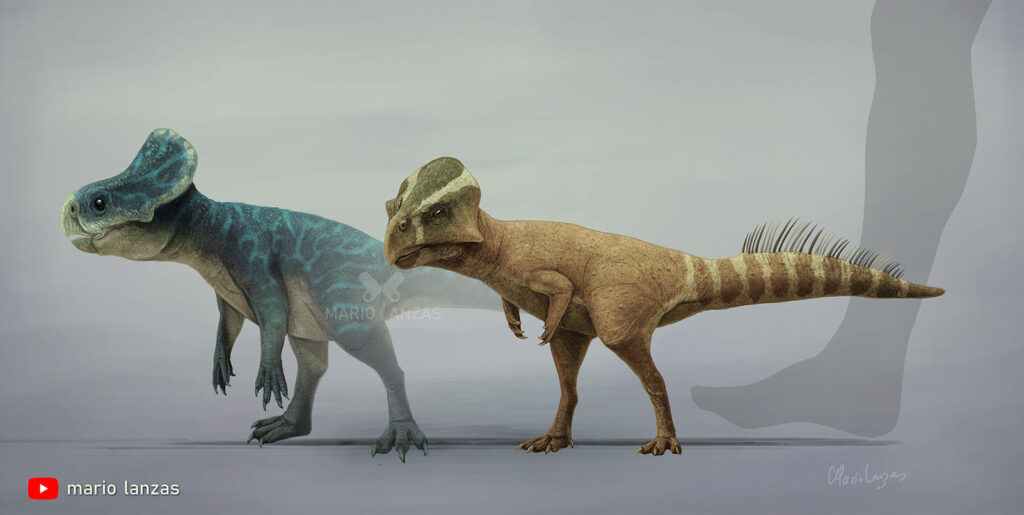
Microceratus is a short, small to medium size of dinosaur estimated to have measured about 2-3 feet. It occurred in the time of the Late Cretaceous; small in size but with unique head shape characteristics. Having it as a herbivorous, which would provide an opportunity of feeding through the low-placed plantlets with very light and compact bodies to avoid thick leaves cover. If its fossil exists, in herds, it indicates that bigger predators are not near.
| Feature | Description |
|---|---|
| Size | About 2 to 3 feet (0.6 to 0.9 meters) long |
| Period | Late Cretaceous |
| Diet | Herbivorous (low-lying plants) |
| Key Features | Distinctive skull shape, lightweight body |
| Habitat | Forested areas and open environments |
| Significance | Insights into herd behavior in herbivores |
12. Caenagnathus

A small theropod dinosaur measuring approximately 5 feet long lived during the Late Cretaceous period. Its elongated beak and special teeth indicate that the Caenagnathus diet was very varied, made of plants and small animals. A light body with long legs could have run fast and probably be agile and fast enough to escape larger predators. The role of Caenagnathus in the adaptations of small theropods in competitive environments is significant.
| Feature | Description |
|---|---|
| Size | About 5 feet (1.5 meters) long |
| Period | Late Cretaceous |
| Diet | Omnivorous (plants and small animals) |
| Key Features | Elongated beak, specialized teeth |
| Habitat | Varied environments, likely forested areas |
| Significance | Adaptations for diverse diets and speed |
13. Choyrodon
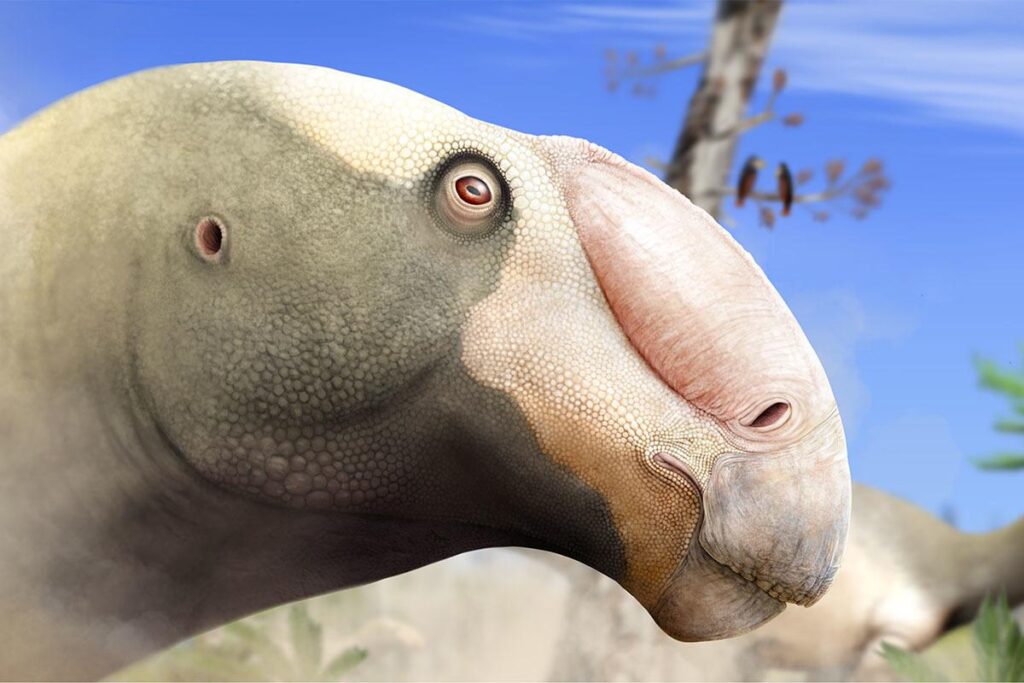
Choyrodon was a Late Cretaceous dinosaur. The dinosaur stood at around 6 feet in length. The plant-eating dinosaur had an elongated beaked mouth and particular teeth that enable it to crush plant matters. The fossils of this species showed that it is a bipedal creature with certain features that provide it the ability to run fast if it sensed any predators. Hence, the species Choyrodon explains the various small ornithopods and their ecological niches during the Cretaceous period.
| Feature | Description |
|---|---|
| Size | About 6 feet (1.8 meters) long |
| Period | Late Cretaceous |
| Diet | Herbivorous (vegetation) |
| Key Features | Beak-like mouth, specialized teeth |
| Habitat | Open woodlands and scrublands |
| Significance | Diversity of small ornithopods |
14. Buitreraptor

Buitreraptor was a small size theropod dinosaur around 3 feet long living during the Late Cretaceous period. It used sharp claws and lightweight in its body, so a small prey is well sought after. Its diet comprises small vertebrates and probably insects, and it was a smaller theropod, such that its specific features with hunting and other aspects for survival make it a particularly important example of diversity with small theropods.
| Feature | Description |
|---|---|
| Size | About 3 feet (0.9 meters) long |
| Period | Late Cretaceous |
| Diet | Carnivorous (small vertebrates and insects) |
| Key Features | Sharp claws, lightweight body |
| Habitat | Forested areas and open environments |
| Significance | Diversity within small theropods |
15. Ornithomimus

Ornithomimus was one of the small ostrich-like dinosaurs, at its best 8 feet in length and sometimes smaller. They are known to live during the Late Cretaceous period. It has slim legs and a lighter skeleton that enabled it to gain a high speed during their run. Ornithomimus was probably omnivorous, consuming a combination of plants, little animals, and perhaps some eggs. Its body suited running at high speeds, as there is evidence that these had a significant role within the ecosystem, evading its predators and seeking sources for food.
| Feature | Description |
|---|---|
| Size | Up to 8 feet (2.4 meters) long (smaller specimens existed) |
| Period | Late Cretaceous |
| Diet | Omnivorous (plants, small animals, eggs) |
| Key Features | Long legs, lightweight body |
| Habitat | Open plains and semi-arid environments |
| Significance | Adaptations for speed and foraging |
16. Stenopelix

Stenopelix is a small dinosaur of the Late Jurassic period, and the length was about 4 feet or 1.2 meters. Its most characteristic features were the broad, flat skull and sturdy body. Being an herbivorous animal, it probably fed on low-lying plants and ferns. The fossils also reflect that it was suited for different types of environment. Its features provide valuable information about the diversity of small dinosaurs in the Jurassic period.
| Feature | Description |
|---|---|
| Size | About 4 feet (1.2 meters) long |
| Period | Late Jurassic |
| Diet | Herbivorous (low-lying plants and ferns) |
| Key Features | Wide, flat skull, robust body |
| Habitat | Varied environments, including forests |
| Significance | Insights into diversity of small dinosaurs |
17. Dromaeosaurid (Small species)
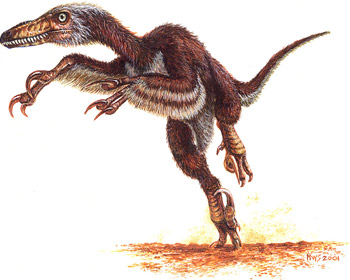
Small dromaeosaurids, usually termed “raptors,” are 3 to 6 feet (0.9 to 1.8 meters) in length as agile hunters. Late Cretaceous dinosaurs like those that possessed sharp claws and long tails for agility or balance would have fed on small vertebrates and insects. Because their features are adaptations toward hunting at high speeds and tactics that are used during a hunt, dromaeosaurids are key factors in the understanding of small theropod ecology.
| Feature | Description |
|---|---|
| Size | About 3 to 6 feet (0.9 to 1.8 meters) long |
| Period | Late Cretaceous |
| Diet | Carnivorous (small vertebrates and insects) |
| Key Features | Sharp claws, long tails |
| Habitat | Varied environments, likely forests |
| Significance | Hunting adaptations in small theropods |
18. Troodon
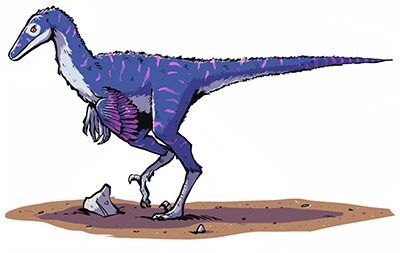
The Troodon measures about 6 to 8 feet long and is considered one of the most intelligent dinosaurs. It lived during the Late Cretaceous period, had big eyes and sharp senses, so it was probably nocturnal. Therefore, it probably ate plants and small animals and maybe even eggs. Such important features in advanced ways like flexible wrist and sharp teeth help to explain its part in the story of dinosaur intelligence and behavior.
| Feature | Description |
|---|---|
| Size | About 6 to 8 feet (1.8 to 2.4 meters) long |
| Period | Late Cretaceous |
| Diet | Omnivorous (plants, small animals, eggs) |
| Key Features | Large eyes, keen senses |
| Habitat | Varied environments, possibly forests |
| Significance | Insights into dinosaur intelligence and behavior |
19. Gallimimus
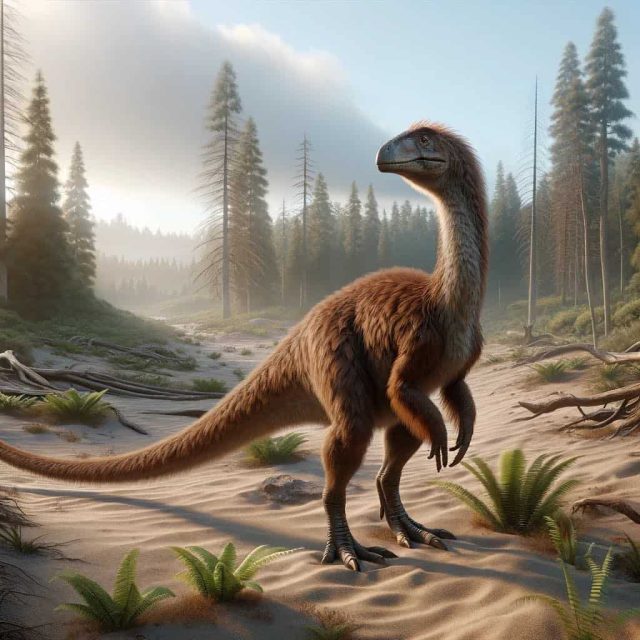
Gallimimus measured about 12 feet in length, and one would consider this one of the larger small dinosaurs often filed under “ostrich-mimic” dinosaurs. This Late Cretaceous theropod sported long legs, a slender body, and an incredibly long neck. Most scientists believe Gallimimus to be an omnivore, which means the individual fed on plants, insects, and small animals. Its body was adapted to allow for incredible speed and agility, suggesting that these traits, in combination with the social nature of its habits, made it very safe to stay in groups or herds to keep a watchful eye for those predators.
| Feature | Description |
|---|---|
| Size | About 12 feet (3.7 meters) long |
| Period | Late Cretaceous |
| Diet | Omnivorous (plants, insects, small animals) |
| Key Features | Long legs, lightweight body |
| Habitat | Open plains and semi-arid environments |
| Significance | Insights into social behavior and adaptations |
Small Prehistoric Animals Beyond Dinosaurs
While the world knows much more about dinosaurs than any other creatures from prehistoric life, small animals existed besides these, like mammals, reptiles, and amphibians. All these were significant parts of their ecological communities and add to the history of the evolutionary story of life on Earth. Knowing small animals opens doors to better understand species’ complex interrelationships and varied environments.
Juramaia

Juramaia is a mammal-like creature that weighed about the size of a small rodent and was living approximately 160 million years ago in the Late Jurassic. This small early mammal is important because it marked a milestone in mammalian evolution. Its fossils proved that it had some qualities that would eventually lead to more advanced mammals. Its anatomy speaks for nocturnal activity, such as large eye sockets, which most probably would give an improved vision for hunting the local insects and other invertebrates at night. Testifying to a creature’s survival portrays the diversifying evolutionary routes that opened channels for mammals to survive, procreate, and persist amidst a world dominated by reptiles.
| Feature | Description |
|---|---|
| Size | About the size of a small rodent |
| Period | Late Jurassic |
| Diet | Insectivorous (insects and small prey) |
| Key Features | Nocturnal adaptations, large eye sockets |
| Habitat | Varied environments, likely woodlands |
| Significance | Insights into early mammalian evolution |
Purgatorius

Another very important small prehistoric animal is Purgatorius, which dates back to the Late Cretaceous, about 66 million years ago. It is as big as a small primate and is one of the earliest known ancestors of modern primates. The fossil evidence of Purgatorius indicates a mix of primitive and advanced traits, such as grasping hands and feet, indicating an arboreal lifestyle. Purgatorius probably fed on fruits, leaves, and insects, and its adaptations hint at the evolutionary changes that would eventually lead to the rise of primates and their descendants.
| Feature | Description |
|---|---|
| Size | Roughly the size of a small primate |
| Period | Late Cretaceous |
| Diet | Omnivorous (fruits, leaves, insects) |
| Key Features | Grasping hands and feet, arboreal adaptations |
| Habitat | Forested areas, likely in trees |
| Significance | Connection to early primate evolution |
Dromaeosaurid (Small Species)
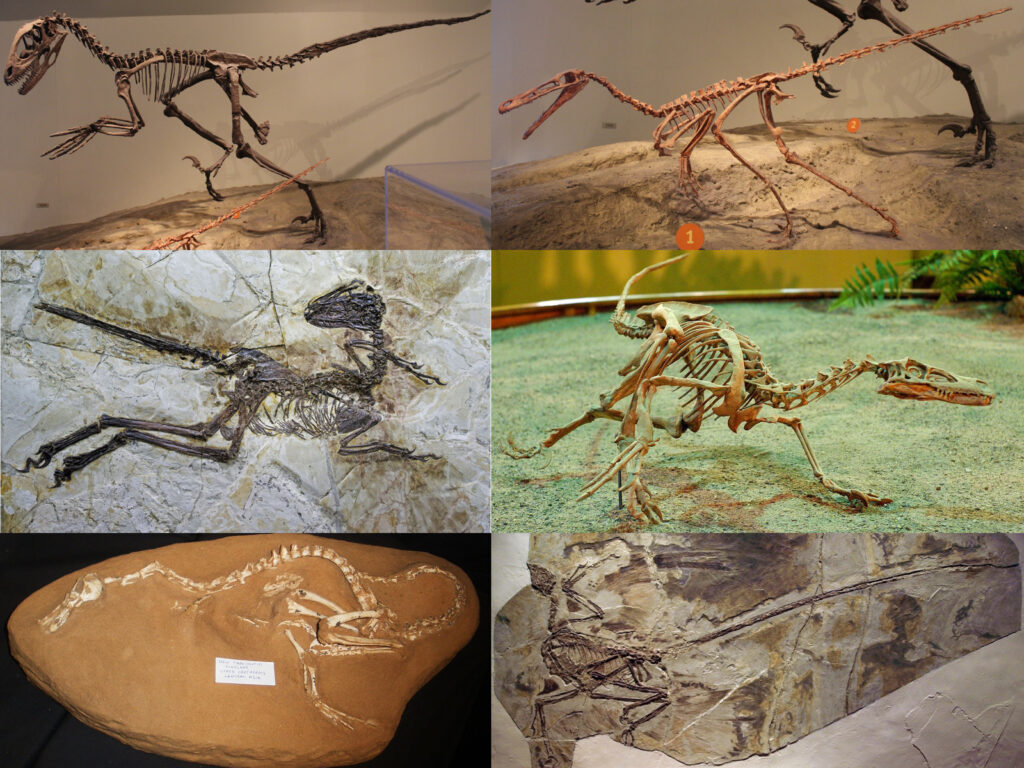
Small dromaeosaurids are very fascinating in their exhibition of smaller diversity of prehistoric reptiles. Such a species is somewhere around 3 to 6 feet in length and characterized by sharp claws and agile body shapes. Their existence started from the Late Cretaceous period, characterized by diverse special adaptations to be very efficient hunters. The prey probably consisted of insects and small vertebrates. The ecological role of theirs then sheds light on predator-prey dynamics of ancient ecosystems and evolutionary pressures for the development.
| Feature | Description |
|---|---|
| Size | About 3 to 6 feet (0.9 to 1.8 meters) long |
| Period | Late Cretaceous |
| Diet | Carnivorous (small vertebrates and insects) |
| Key Features | Sharp claws, lightweight and agile body |
| Habitat | Varied environments, likely forests |
| Significance | Insights into small predator dynamics |
Conclusion
In summary, the discovery of small dinosaurs and prehistoric animals represents a tapestry of life that coexisted with the larger, more gargantuan creatures. Examples range from tiny theropods like Buitreraptor to small mammals such as Juramaia; all of these played an important role in their ecosystems while showcasing unique adaptations that made it possible for them to survive and thrive in very different habitats. The small species also help us better understand the past and depict evolutionary pathways to the biodiversity that is seen today.
If we look at the diversity of life in prehistoric times, then it becomes clear that smaller species had a big role in the ecological dynamics of their environment. They filled many niches, both as prey and predators, and often their adaptations paved the way for larger species’ evolutionary success. The study of these small creatures offers invaluable insights into the complexity of prehistoric ecosystems and the interconnections that define life on Earth.
It is by the study of the smaller species that understanding of the larger ecological dynamics is derived. The interactions between them and the larger organisms, as well as the response to environmental change in such ancient ecosystems, add much depth to understanding those same ancient ecosystems. The evolutionary history of such small dinosaurs and other extinct animals may draw similarities with modern ecosystems, providing much-needed information for the planning of conservation efforts and giving much greater insight into biodiversity.
Additional Resources
For those interested in delving deeper into the world of dinosaurs and prehistoric animals, the following resources are recommended:
- Books:
- “The Rise and Fall of the Dinosaurs: A New History of a Lost World” by Steve Brusatte
- “The Dinosaurs of Waterhouse Hawkins” by Barbara Kerley
- “Prehistoric Animals: A Visual Encyclopedia” by David Lambert
- Documentaries:
- “Walking with Dinosaurs” (BBC)
- “Prehistoric Planet” (Apple TV+)
- “The Real Jurassic Park” (PBS)
- Articles:
- National Geographic’s online articles about prehistoric life
- Scientific American’s coverage on the evolution of dinosaurs and mammals
- Museum Exhibits:
- The American Museum of Natural History (New York) – exhibits on dinosaurs and prehistoric life
- The Natural History Museum (London) – featuring dinosaur galleries and fossil displays
- The Field Museum (Chicago) – home to Sue, the famous T. rex, along with other prehistoric exhibits
These resources provide excellent opportunities for further exploration and understanding of the fascinating world of prehistoric animals and their environments.


1 Comment
Pingback: Top 10 Fastest Dinosaurs Ever Lived on Earth - Dino Guider